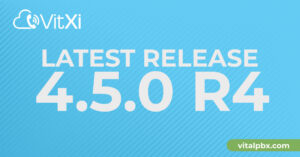[Here is the complete content of the blog, including introduction, main sections with subtitles, and conclusion]
PBX End-of-Life: What to Do When Your Vendor Walks Away
It’s the news no business wants to hear: your trusted Private Branch Exchange (PBX) system vendor has announced its End-of-Life (EOL). Suddenly, the communication backbone of your organization faces an uncertain future. This PBX End-of-Life scenario isn’t just an inconvenience; it’s a critical juncture that demands immediate attention and strategic planning.
Feeling stranded? You’re not alone. Many businesses rely on legacy PBX systems, and vendor discontinuation is a common challenge. But don’t panic. This announcement is actually an opportunity – a chance to reassess your communication needs and upgrade to a more modern, efficient, and secure solution fit for 2025 and beyond.
This guide will walk you through everything you need to know about navigating a PBX EOL situation. We’ll cover the risks of inaction, how to evaluate your current setup, explore replacement options, and plan a smooth migration. Let’s turn this challenge into a strategic advantage for your business communications.
Understanding PBX End-of-Life (EOL): More Than Just an Announcement
So, what exactly does PBX End-of-Life mean? It’s not just about the vendor stopping sales of that particular model. EOL signifies a crucial shift in the vendor’s commitment.
What is PBX EOL? Breaking Down the Terminology
Typically, an EOL announcement follows a lifecycle:
- End-of-Sale (EOS): The date the vendor stops selling the specific PBX hardware or software version.
- End-of-Support (EOS / EOL): This is the critical date. After this, the vendor will no longer provide technical support, software updates, patches, or replacement parts for the system.
Essentially, PBX End-of-Life means your system is officially unsupported by the people who made it. You’re on your own.
The Hidden Dangers: Risks of Using an Unsupported PBX
Continuing to use an EOL PBX system might seem like a way to save money in the short term, but it exposes your business to significant risks:
- Severe Security Vulnerabilities: Without security patches, your EOL PBX becomes an easy target for hackers. Toll fraud, data breaches, and eavesdropping become serious possibilities. Relying on outdated systems is a major cybersecurity risk [Link to reputable source on cybersecurity risks].
- Compliance Nightmares: Industries with strict regulations (like healthcare with HIPAA or finance with PCI DSS) require secure communication systems. An unsupported PBX likely fails compliance audits, leading to hefty fines and reputational damage.
- Skyrocketing Maintenance Costs: Finding spare parts for obsolete hardware becomes difficult and expensive. Third-party support, if available, often comes at a premium and may lack deep expertise.
- Lack of Modern Features: Legacy PBX systems can’t compete with modern Unified Communications (UC) features like video conferencing, instant messaging, mobile integration, and advanced call routing that boost productivity.
- Integration Headaches: Trying to connect your EOL PBX with newer software (like CRMs) or hardware becomes increasingly complex and often impossible.
- System Instability and Downtime: Without updates, the system becomes prone to crashes and failures, disrupting critical business communications and potentially losing customers.
Ignoring a PBX EOL notice isn’t a viable strategy; it’s a ticking time bomb for your business operations.
The Clock is Ticking: Assessing Your Current Legacy PBX Situation
Now that you understand the risks, it’s time to evaluate your specific circumstances. Proactive assessment is key to a smooth transition away from your legacy PBX system.
Confirming Your PBX EOL Status
Don’t rely on hearsay. Verify the EOL announcement directly:
- Check the vendor’s official website for product lifecycle announcements.
- Contact your vendor account manager or support channel.
- Look for official email notifications regarding your specific model.
Knowing the exact End-of-Support date gives you a clear deadline for migration.
Taking Stock: Inventory Your Current Setup
Before exploring replacements, you need a complete picture of your existing infrastructure:
- Hardware: Document PBX models, servers, phones (desk phones, conference phones), gateways, and interface cards.
- Software: Note the PBX software version and any integrated applications (call accounting, recording, CRM connectors).
- Network: Understand how the PBX integrates with your LAN/WAN.
- Lines & Numbers: List all phone numbers, Direct Inward Dial (DID) ranges, and types of service (PRI, SIP Trunks, analog lines).
- Configuration: Document call routing rules, voicemail setups, auto-attendants, hunt groups, and user configurations.
This inventory is crucial for planning the migration and ensuring feature parity or improvement with a new system.
Evaluating Your Business Communication Needs for 2025
Your business has likely evolved since the legacy PBX was installed. Use this EOL event to redefine your communication requirements:
- User Count & Scalability: How many users do you have now? Do you anticipate growth or seasonal fluctuations?
- Mobility & Remote Work: Do your employees need to make/receive business calls from mobile devices or home offices?
- Collaboration Tools: Is there demand for video conferencing, screen sharing, or team messaging? [Link to VitalPBX features page showcasing UC]
- Integrations: Do you need integration with CRM, helpdesk software, or other business applications?
- Call Center Features: If applicable, what are your needs for call queuing, recording, reporting, and analytics?
- Budget: What is a realistic budget for a new system, considering both upfront and ongoing costs?
Aligning your next phone system with current and future business needs is paramount. Don’t just replace; upgrade strategically.
The Real Cost of Staying Put
Consider the hidden costs associated with sticking with an EOL PBX:
- Lost productivity due to outdated features or system downtime.
- Potential costs of security breaches or compliance failures.
- High expenses for scarce spare parts and specialized support.
- Missed opportunities due to poor customer communication experiences.
Often, the cost of not migrating significantly outweighs the investment in a modern solution.
Navigating Your Options: Choosing the Right Path Forward After PBX EOL
With your assessment complete, you can explore the market for PBX replacement options. The landscape has changed significantly, offering more flexibility and features than ever before. The main contenders in 2025 are typically Cloud-Hosted PBX and On-Premise IP PBX solutions.
Option 1: Cloud-Hosted PBX (UCaaS)
Cloud-hosted solutions, often called Unified Communications as a Service (UCaaS), deliver phone services over the internet from the provider’s data centers.
- Pros:
- Lower upfront costs (typically subscription-based).
- Scalability – easily add or remove users.
- Maintenance and updates handled by the provider.
- Excellent support for remote and mobile workers.
- Access to the latest UC features. [Link to external article on Cloud Communications benefits]
- Cons:
- Reliant on internet connectivity.
- Potentially higher long-term costs (ongoing subscriptions).
- Less control over system customization and security protocols.
- Voice quality can be affected by internet performance.
Option 2: On-Premise IP PBX
An On-Premise IP PBX involves hosting the phone system hardware and software within your own business premises or private data center. Modern IP PBXs utilize VoIP technology.
- Pros:
- Greater control over system configuration, security, and data.
- Potentially lower total cost of ownership over the long term (after initial investment).
- Not solely dependent on public internet quality for internal calls.
- Can leverage existing network infrastructure.
- Cons:
- Higher upfront investment in hardware and software.
- Requires in-house IT expertise for management and maintenance.
- Scalability might require additional hardware purchases.
- Responsible for updates, security, and backups.
Option 3: Hybrid PBX Solutions
A hybrid approach combines elements of both cloud and on-premise systems. For example, you might have an on-premise PBX core but utilize cloud services for specific features like video conferencing or SIP trunking. This offers flexibility but can add complexity.
Making the Choice: Cloud vs. On-Premise in 2025
The “best” option depends entirely on your business needs, resources, and priorities identified during your assessment:
- Choose Cloud if: You prioritize flexibility, remote work, minimal IT burden, and predictable monthly costs.
- Choose On-Premise if: You prioritize control, customization, security oversight, have strong IT resources, and prefer a capital expenditure model. Consider robust solutions like VitalPBX for a feature-rich, controllable on-premise experience. [Link to relevant VitalPBX article on On-Premise PBX benefits]
Don’t rush this decision. Evaluate providers and solutions based on features, reliability, support, security, and pricing models.
Planning Your Smooth Transition: Migrating from Your Old PBX
Once you’ve chosen your path forward, meticulous planning is essential for a seamless legacy PBX migration strategy. A bumpy transition can disrupt business operations significantly.
Step 1: Develop a Detailed Migration Plan
Your plan should outline:
- Timelines: Set realistic deadlines for each phase (vendor selection, setup, testing, go-live, old system decommissioning). Factor in your EOL date.
- Team & Responsibilities: Assign roles for project management, technical implementation, user training, and communication.
- Budget Allocation: Detail costs for hardware, software, licenses, installation, training, and potential network upgrades.
- Risk Management: Identify potential roadblocks (e.g., number porting delays, compatibility issues) and plan contingencies.
Step 2: Select Your New Vendor/Solution Partner
Choose a provider that aligns with your chosen path (Cloud or On-Premise) and meets your specific needs. Look for:
- Proven track record and positive customer reviews.
- Robust feature set matching your requirements.
- Strong security practices.
- Responsive technical support.
- Clear Service Level Agreements (SLAs).
- Experience with migrations from legacy systems like yours.
Step 3: Prepare Your Network
Modern IP-based phone systems rely heavily on your network infrastructure. Ensure your network can handle the increased VoIP traffic:
- Assess bandwidth requirements.
- Check Quality of Service (QoS) settings on routers and switches.
- Consider Power over Ethernet (PoE) switches for IP phones.
- Update firewall rules to allow necessary traffic.
Step 4: Data Migration and Configuration
This involves replicating your essential configurations on the new system:
- Rebuild user extensions, voicemail boxes, auto-attendants, call queues, and routing rules.
- Migrate contact directories if possible.
- Set up integrations with other business applications.
Step 5: Number Porting (Keeping Your Phone Numbers)
One of the biggest concerns is keeping existing business phone numbers. This process, called Local Number Portability (LNP), needs careful coordination with your old and new providers. Start this early, as it can sometimes take several weeks. Confirm the process and required documentation with your chosen vendor.
Step 6: Thorough Testing
Before going live, rigorously test the new system:
- Test inbound and outbound calls (internal, external, international).
- Verify all features: voicemail, call forwarding, conferencing, IVR menus, etc.
- Test call quality under normal and peak load conditions.
- Confirm integrations are working correctly.
- Conduct failover testing if redundancy is part of your setup.
Step 7: User Training and Go-Live
Train your employees on how to use the new system before the cutover date. Provide quick reference guides and support resources. Schedule the final cutover during off-peak hours to minimize disruption. Have support staff (internal or vendor) readily available on go-live day.
Step 8: Decommission the Old PBX
Once the new system is stable and running smoothly, formally decommission the old EOL PBX hardware according to secure data disposal practices.
A well-planned business phone system upgrade minimizes disruption and ensures your team can leverage the new system’s benefits immediately.
Why VitalPBX is Your Go-To Solution Post-EOL
Navigating a PBX End-of-Life event presents a unique opportunity to implement a truly modern and flexible communication system. If control, customization, and a feature-rich on-premise or private cloud solution align with your needs, VitalPBX stands out as an exceptional choice.
VitalPBX is more than just a replacement; it’s an upgrade designed for the demands of businesses in 2025:
- Flexibility: Deploy VitalPBX on your own hardware, virtualized environment, or in a private cloud – you choose what works best for your infrastructure and security posture.
- Scalability: Start with what you need and easily scale your system as your business grows without hefty licensing penalties often associated with legacy systems.
- Rich Feature Set: Get enterprise-grade Unified Communications features out-of-the-box, including video conferencing, mobile apps (iOS & Android), call center modules, advanced call routing, CRM integrations, and much more. [Link to VitalPBX Solutions Page]
- Cost-Effective: VitalPBX offers a compelling Total Cost of Ownership (TCO) compared to many proprietary systems, especially when migrating from an EOL platform facing high maintenance costs.
- Security Focused: Gain control over your communication security. VitalPBX includes built-in security features and allows you to implement your own robust security protocols on your infrastructure.
- No Vendor Lock-in: Based on open standards like Asterisk, VitalPBX gives you freedom and prevents the exact EOL situation you’re currently facing. You control your communication destiny.
- Active Development & Support: Benefit from continuous development, regular updates, and accessible support resources, ensuring your communication system remains current and secure. [Link to VitalPBX Support Page or Community Forum]
Making the switch from an unsupported legacy system to VitalPBX empowers your business with reliable, modern communications tailored to your specific requirements.
Frequently Asked Questions about PBX End-of-Life
Here are answers to some common questions businesses face when their PBX vendor announces EOL:
Q1: How do I know for sure if my PBX is End-of-Life?
- Check the manufacturer’s website for official product lifecycle announcements. Contact your vendor or reseller directly. Look for specific End-of-Sale and End-of-Support dates for your model.
Q2: Can I still use my PBX after the End-of-Support date?
- Technically, yes, the system might continue to function. However, it’s highly risky due to security vulnerabilities, lack of updates, potential compliance issues, difficulty finding parts, and absence of vendor support if things go wrong.
Q3: What are the biggest risks of ignoring a PBX EOL notice?
- The top risks include major security breaches (hacking, toll fraud), non-compliance penalties, system instability and failures disrupting business, high costs for unsupported maintenance, and falling behind competitors due to lack of modern features.
Q4: How long does it typically take to migrate from an old PBX?
- Migration time varies greatly depending on the size and complexity of your organization, the chosen replacement solution, and how well you plan. It can range from a few weeks for small businesses to several months for larger enterprises. Start planning as soon as you know the EOL date.
Q5: Can I keep my existing phone numbers when I switch systems?
- Yes, in most regions, regulations allow you to port your existing phone numbers to a new provider/system through Local Number Portability (LNP). Coordinate this process carefully with both your old and new service providers early in the migration planning.
Q6: Is a cloud PBX always cheaper than an on-premise one?
- Not necessarily. Cloud PBX typically has lower upfront costs but higher ongoing subscription fees. On-premise has a higher initial investment but can have a lower Total Cost of Ownership (TCO) over several years, especially for larger organizations. Analyze costs over a 3-5 year period for a true comparison.
Conclusion: Turn PBX EOL into a Communication Evolution
Receiving a PBX End-of-Life notice can feel like a setback, but it’s truly an inflection point. Sticking with an unsupported system invites unacceptable risks – from security breaches to operational failures. Instead, view this as a catalyst for positive change.
By carefully assessing your current situation, understanding your future needs, and exploring modern solutions like versatile On-Premise IP PBXs or Cloud Communications, you can transition smoothly. The key steps involve thorough planning, choosing the right replacement path (Cloud, On-Premise like VitalPBX, or Hybrid), meticulous migration execution, and user adoption.
Don’t let vendor decisions dictate your business’s communication capabilities or security posture. Take control of your transition. Embrace the opportunity to modernize, enhance productivity, improve security, and future-proof your business communications for 2025 and beyond.
Ready to move past the limitations of your End-of-Life PBX?
Explore a powerful, flexible, and secure future for your business communications.
Download VitalPBX Today and Start Your Free Trial!
Take the first step towards a modern communication system designed for your control and your success.
[/Here is the complete content of the blog, including introduction, main sections with subtitles, and conclusion]





